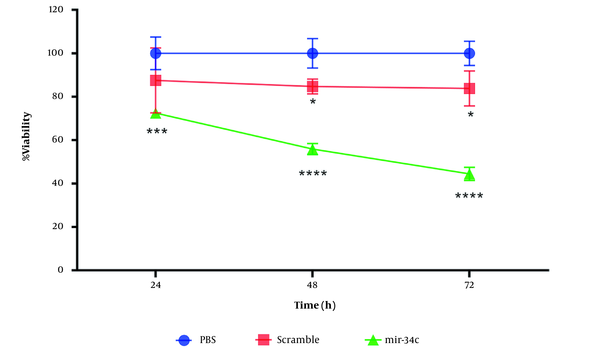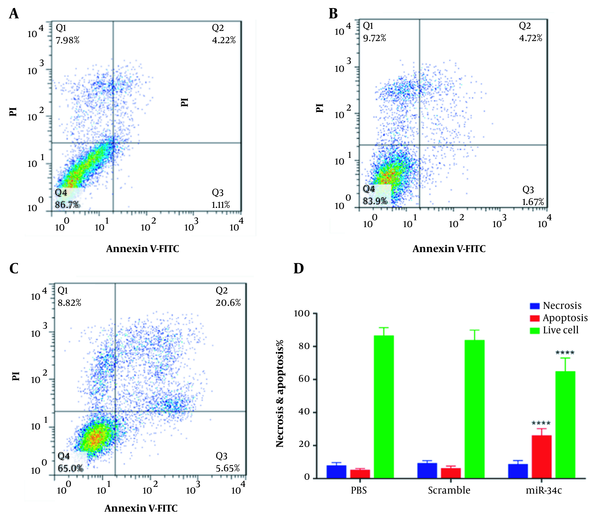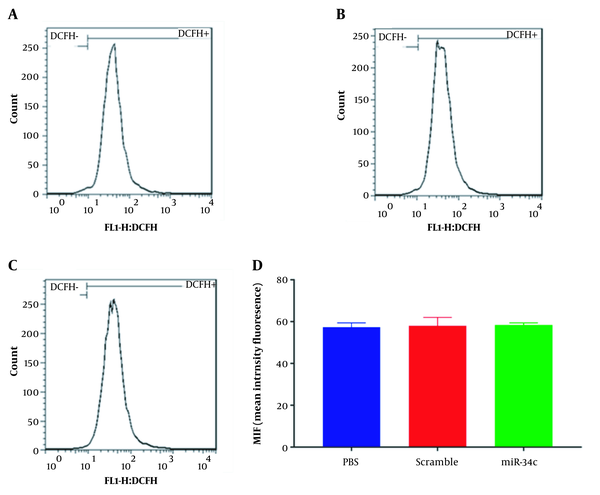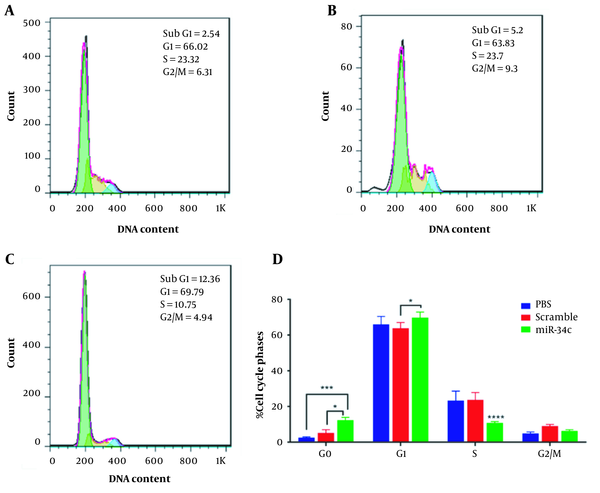1. Background
Infectious diseases cause premature deaths in thousands of people worldwide every day (1-4). Numerous commercial antibiotics are used worldwide to control human infections and infectious diseases. The long-term use of these antibiotics has caused the incidence of bacterial resistance to several drugs, leading to serious problems in the treatment of infectious diseases (5-7). Therefore, it is necessary to conduct extensive research to discover new antimicrobial substances from various herbal and animal sources. Medicinal plants have grabbed special interest as a potential source of new antimicrobials due to their substances with low toxicity. During their secondary metabolism, plants make many compounds with complex molecular structures, some of which show potent antimicrobial properties (8-10).
Saponaria officinalis, known as Coven, is an herbaceous perennial plant with a height of 30 - 100 cm. This plant grows in wet ditches, on roadsides, in areas of waste disposal, near old houses, and in pastures. This plant is also grown as an ornamental plant. Saponaria officinalis contains large amounts of saponins, which foams during extraction with water. This plant has been used as an alternative medicine since the time of Dioscorides. This plant can also be used as an anti-scrofula, calagogue, expectorant, diaphoretic, weak diuretic, expectorant, cleanser, and tonic agent. The decoction derived from this plant is locally applied to treat skin itching (11, 12).
Malva sylvestris, with the scientific name M. sylvestris L, belongs to the Malvaceae family and is a medicinal plant endemic to Iran. This plant has high nutritional and medicinal value. All parts of this plant have medicinal uses, but its flowers and leaves are more commonly applied in Iranian traditional medicine to treat diseases. This plant possesses numerous biological properties, including antiseptic, oral wound healing, analgesic, anti-inflammatory, antioxidant, and antibacterial properties, inhibiting the growth of staphylococci and streptococci. Also, mouthwashes containing the leaf extract of this plant have been used as a treatment for oral lesions and inflammation due to the presence of mucilage, flavonoids, and tannins (13-15).
Pomegranate, with the scientific name of Froriepia subpinnata, belongs to the Punicaceae family. Other common names for this plant include grenade, geranat, and Punica apple. Froriepia subpinnata has been widely used as a traditional medicine in many countries to treat dysentery, diarrhea, worm infections, acidosis, bleeding, and respiratory diseases. In addition, F. subpinnata has antioxidant, anti-atherostatic, antimicrobial, and antiviral properties. The constituents of P. granatum include gallocatechin, delphinidin, cyanidin, gallic acid, ellagic acid, pelargonidin, and sitosterol, which are well-known due to their therapeutic properties (16-18).
Urtica dioica, with the scientific name of U. dioca L, is an herbaceous perennial flowering plant that grows all over the world. This plant belongs to the Urticaceae family and is considered an important medicinal plant because of its high amounts of minerals (iron, manganese, potassium, and calcium), chlorophyll, amino acids, carotenoids, vitamins, flavonoids, tannins, sterols, polysaccharides, and cholestin (19, 20).
Regarding the increasing rate of bacterial resistance against antibiotics, these plants, due to their antibacterial compounds, can be valuable sources for developing novel antimicrobial agents.
2. Objectives
We here investigated the effects of the methanol extracts of these plants on the growth of a number of pathogenic bacteria.
3. Methods
The methanolic extracts of E. caucasicum trautv (leaf), S. officinalis (flower), F. subpinnata (leaf), M. sylvestris (leaf), and U. dioica (leaf) were prepared. The plants were collected from the northern regions of Iran in spring (2022). Then the samples were dried and milled under shade at room temperature. In order to prepare the plant extracts using the cold maceration method, 20 grams of powdered plant leaves were soaked separately in methanol and transferred to a shaker for 24 hours, followed by filtering through Whatman No. 2 filter paper (21, 22). Then the solvent was removed from the filtered material using a rotary vacuum device. The concentrated extract was kept for 48 hours in an oven at 40 degrees Celsius until obtaining pure extracts and the complete removal of the solvent. Finally, the obtained extracts were dried, weighed, and kept in the refrigerator at 4 degrees Celsius until further testing (23, 24).
3.1. Bacterial Strains and Culture Condition
Bacterial strains, including S. dysenteriae, R. tritici, E. coli, and L. monocytogenes, were obtained from the Laboratory of the Veterinary Medicine Department of the University of Zabol, propagated on nutrient agar culture medium, and kept in a refrigerator at 4 degrees Celsius until use. Bacterial suspensions were prepared from fresh and young bacterial cultures by transferring several colonies to the Mueller Hinton Broth culture medium (25).
The turbidity of the prepared microbial suspensions was adjusted to 0.5 McFarland standard (corresponding to 1.5 × 108 bacteria per mL) by setting light absorption at 630 nm in the range of 0.08 to 0.1. A concentration of 1.5× 107 bacteria per milliliter was obtained by diluting the 0.5 McFarland bacterial suspension by one-tenth (26, 27). The antimicrobial effects of the plant extracts at a concentration of 100 mg/mL were investigated using the agar diffusion method. A sterile swab was soaked in the bacterial suspension with turbidity equal to 1.5 × 107 bacteria per mL and was used to uniformly culture bacteria on Mueller Hinton agar. Then several sinkholes with a diameter of 6 mm and a depth of 5 mm were created at suitable intervals, and 100 microliters of the extracts were poured into the sinkholes. Ciprofloxacin antibiotic was used as a positive control. After 24 hours of incubation at 37°C, the diameter of the growth inhibition zone was measured in mm. All the experiments were repeated three times to obtain accurate results (28).
4. Results
The results of this study showed that the extracts of E. caucasicum trautv, S. officinalis, M. sylvestris, U. dioica, and F. subpinnata had variable growth inhibitory effects on S. dysenteriae, R. tritici, E. coli, and L. monocytogenes (P < 0.01, Table 1). Among all the plants used, F. subpinnata had the largest diameter of inhibition zone (6 mm) against S. dysenteriae (Figure 1). Also, F. subpinnata extract showed the largest inhibition zone diameter (4 mm) against R. tritici (Figure 2). The extracts of E. caucasicum and F. subpinnata revealed the largest diameter of the inhibition zone (3 mm) against Xanthomonas translucens (Figure 3). The largest inhibition zone diameter (8 mm) of M. sylvestris was observed against E. coli (Figure 4), and the extracts of E. caucasicum and U. dioica caused the largest diameter of inhibition zone (5 mm) against L. monocytogenes (Figure 5).
Variance Analysis of Bacterial Growth Inhibition Zone at a Concentration of 100 mg/mL of the Methanolic Extracts of the Plant Studied
5. Discussion
In this research, F. subpinnata plant extract had the largest diameter of inhibition zone against S. dysenteriae. The extracts of E. caucasicum and F. subpinnata delivered the largest diameters of inhibition zone against Xanthomonas translucens, and M. sylvestris plant extract revealed the largest inhibition zone diameter against E. coli. Finally, E. caucasicum and U. dioica plant extracts showed the largest diameter of inhibition zone against L. monocytogenes.
In the study of Sengul et al., the inhibition zone diameters observed for the methanolic extract of S. officinalis against Bacillus subtilis, Staphylococcus aureus, Streptococcus pyogenes, and Salmonella typhimurium were equal to 10, 18, 0, and 12 mm, respectively (29). In a study by Veda et al., ethyl acetate extract of S. officinalis delivered the inhibition zone diameters of 12.67 ± 0.33, 14, 12.3 ± 0.33, 16, and 13.67 ± 0.33 mm against L. monocytogenes, Staphylococcus aureus, Streptococcus pneumoniae, E. coli, and Pseudomonas aeruginosa, while the inhibition zone diameters of the methanolic extract of this plant against these bacteria were obtained as 13.33 ± 0.33, 14.23 ± 0.33, 16, 19.67 ± 0.33, and 17.67 ± 0.33 mm, respectively (30). In another study, Nabinejad, who investigated the antimicrobial activity of S. officinalis extract against E. coli, reported that the inhibition zone diameters in the dilutions of 10, 15, and 20 microliters were equal to 16, 18, and 19 mm, respectively (31).
In the study of Choi et al., who investigated the in vitro and in vivo antimicrobial activity of F. subpinnata extract against 16 Salmonella samples, the results showed that the inhibitory concentration range was between 62.5 and 1000x03 BCg mL-1. In addition, F. subpinnata extract inhibited Salmonella Typhimurium infection in mice (32). In the study of Jam et al., the antimicrobial and anti-biofilm activities of F. subpinnata L. and Areca nut were investigated against several Gram-positive and Gram-negative resistant bacteria, including Staphylococcus aureus, E. coli, Salmonella, and Enterobacter aeruginosa. The results showed that the antimicrobial and anti-biofilm activities of the plant extracts were dose-dependent, showing strong growth inhibitory effects against S. aureus (98.98%), E. coli (94.98%), and E. aeruginosa (88.55%) (33). Niknejad and Asgharian, who assessed the antibacterial and antioxidant effects of U. dioica leaf essential oil harvested from Tonekabon, Iran, reported that U. dioica leaf essential oil had acceptable antibacterial effects on Gram-positive and Gram-negative bacteria except for Bacillus subtilis, where IC50 and AAI were 21.53 and 2.116 μg/mL, respectively. The main chemical compounds of the extract were found to be phytol (35%), nonanal (3.15%), b-Ionone (0.9%), Phtaleic acid (4.7%), and Carvacrol (5.3%) (34).
In the study of Hashemi et al., the antimicrobial and healing effects of different extracts of U. dioica, as well as burdock and Nasturtium with Silver Sulfadiazine, were investigated on burn infections caused by S. aureus in mice (35). The results showed that in this animal model, the aqueous and ethanolic extracts of U. dioica and oleander and burdock root extracts had antimicrobial activity against the growth of S. aureus, suggesting potent bactericidal effects for the aqueous and ethanolic extracts of U. dioica, Nasturtium, and burdock (36). In the study of Roshani et al., they investigated the antibacterial effects of the acetonic and methanolic extracts of U. dioica and Shirazi thyme against P. aeruginosa expressing metallo-beta-lactamase genes (bla IMP and bla VIM), 83 strains of which were imipenem-resistant while 48 strains showed the CDDT (imipenem-imipenem + EDTA) metallo-beta-lactamase positive phenotype. Among these strains, six expressed the bla IMP gene, but none of them were positive for the bla VIM gene. The results of the recent study showed that the methanolic and acetonic extracts of U. dioica and Shirazi thyme were effective on IMP-producing P. aeruginosa strains (37).
Oxidation in the human body damages cell membranes and other structures, including cellular proteins, lipids, and DNA. When oxygen is metabolized, it creates unstable molecules called free radicals, which steal electrons from other molecules. This causes damage to the structure of DNA and other cellular components. The body can neutralize some free radicals and even needs them to function effectively, but the damage caused by the excess of free radicals over time may be irreparable, leading to certain diseases, including heart and liver diseases and some cancers such as mouth, esophagus, stomach, and intestinal cancers (38).
Sources of antioxidants can be natural or synthetic. Some plants are thought to be rich in antioxidants, which comprise a type of plant nutrients. The body obtains antioxidants from either endogenous or exogenous sources. The antioxidants that enter the body from the outside are called exogenous (39). Antioxidants, sometimes called "free radical scavengers," are essential for preventing the damage caused by free radicals or unstable molecules produced in response to environmental stress and other insults (40).
5.1. Conclusions
The results of this study showed that the methanolic extract of E. caucasicum was the most potent plant extract in inhibiting the growth of some bacteria, including S. dysenteriae, R. tritici, and L. monocytogenes. The growth of E. coli, however, was most effectively inhibited by M. sylvestris extract, suggesting this plant extract is a potential treatment for infections caused by this organism.




